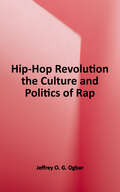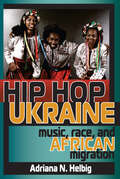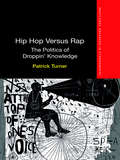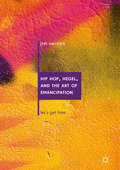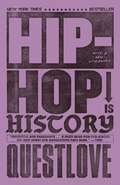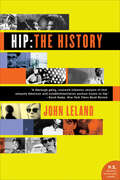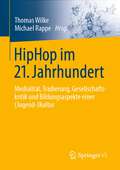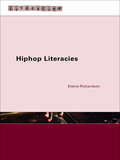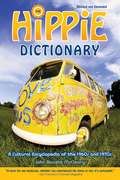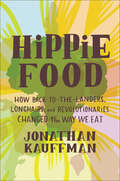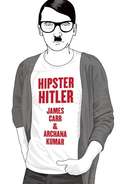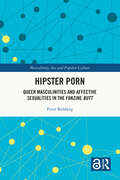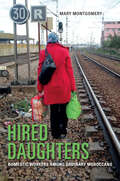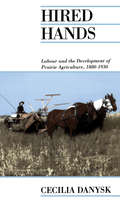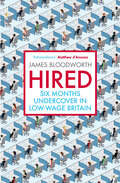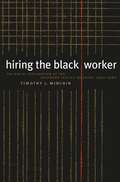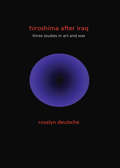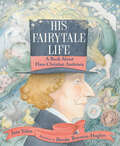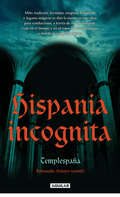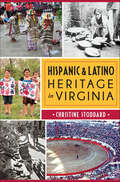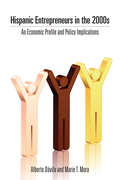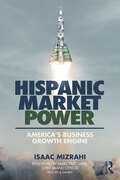- Table View
- List View
Hip Hop Revolution: The Culture and Politics of Rap
by Jeffrey O. G. OgbarIn the world of hip-hop, "keeping it real" has always been a primary goal—and realness takes on special meaning as rappers mold their images for street cred and increasingly measure authenticity by ghetto-centric notions of "Who's badder?" <p><p>In this groundbreaking book, Jeffrey O. G. Ogbar celebrates hip-hop and confronts the cult of authenticity that defines its essential character—that dictates how performers walk, talk, and express themselves artistically and also influences the consumer market. Hip-Hop Revolution is a balanced cultural history that looks past negative stereotypes of hip-hop as a monolith of hedonistic, unthinking noise to reveal its evolving positive role within American society. <p><p>A writer who's personally encountered many of hip-hop's icons, Ogbar traces hip-hop's rise as a cultural juggernaut, focusing on how it negotiates its own sense of identity. He especially explores the lyrical world of rap as artists struggle to define what realness means in an art where class, race, and gender are central to expressions of authenticity—and how this realness is articulated in a society dominated by gendered and racialized stereotypes. Ogbar also explores problematic black images, including minstrelsy, hip-hop's social milieu, and the artists' own historical and political awareness. Ranging across the rap spectrum from the conscious hip-hop of Mos Def to the gangsta rap of 50 Cent to the "underground" sounds of Jurassic 5 and the Roots, he tracks the ongoing quest for a unique and credible voice to show how complex, contested, and malleable these codes of authenticity are. Most important, Ogbar persuasively challenges widely held notions that hip-hop is socially dangerous—to black youths in particular—by addressing the ways in which rappers critically view the popularity of crime-focused lyrics, the antisocial messages of their peers, and the volatile politics of the word "nigga." <p><p>Hip-Hop Revolution deftly balances an insider's love of the culture with a scholar's detached critique, exploring popular myths about black educational attainment, civic engagement, crime, and sexuality. By cutting to the bone of a lifestyle that many outsiders find threatening, Ogbar makes hip-hop realer than it's ever been before.
Hip Hop Ukraine: Music, Race, and African Migration (Ethnomusicology Multimedia)
by Adriana N. Helbig&“[A] magnificent study . . . adds to the burgeoning scholarship on global hip hop and furthers our knowledge of the African diaspora in Eastern Europe.&” —Anthropology of East Europe ReviewsFeatured in NPR&’s &“Read These 6 Books About Ukraine&” In Hip Hop Ukraine, we enter a world of urban music and dance competitions, hip hop parties, and recording studio culture to explore unique sites of interracial encounters among African students, African immigrants, and local populations in eastern Ukraine. Adriana N. Helbig combines ethnographic research with music, media, and policy analysis to examine how localized forms of hip hop create social and political spaces where an interracial youth culture can speak to issues of human rights and racial equality. She maps the complex trajectories of musical influence—African, Soviet, American—to show how hip hop has become a site of social protest in post-socialist society and a vehicle for social change.&“This is a unique and admirable book that traces a complex trail from hip hop created by African migrants in Ukraine through remote African-American influences to their origins in Uganda and back again.&” —Slavic Review&“Portrays the music as a forceful influence on worldwide social and cultural expression.&” —Slavonic and East European Review&“A well-conceived study of the role and significance of hip hop in Ukraine. It joins the ranks of other very timely chronicles on the impact of hip hop in various societies around the world.&” —Allison Blakely, Boston University
Hip Hop Versus Rap: The Politics of Droppin' Knowledge (Routledge Advances in Ethnography)
by Patrick Turner'What is the real hip hop?' 'To whom does hip hop belong?' 'For what constructive purposes can hip hop be put to use?' These are three key questions posed by hip hop activists in Hip Hop Versus Rap, which explores the politics of cultural authenticity, ownership, and uplift in London’s post-hip hop scene. The book is an ethnographic study of the identity, role, formation, and practices of the organic intellectuals that populate and propagate this ‘conscious’ hip hop milieu. Turner provides an insightful examination of the work of artists and practitioners who use hip hop ‘off-street’ in the spheres of youth work, education, and theatre to raise consciousness and to develop artistic and personal skills. Hip Hop Versus Rap seeks to portray how cultural activism, which styles itself grassroots and mature, is framed around a discursive opposition between what is authentic and ethical in hip hop culture and what is counterfeit and corrupt. Turner identifies that this play of difference, framed as an ethical schism, also presents hip hop’s organic intellectuals with a narrative that enables them to align their insurgent values with those of policy and to thereby receive institutional support. This enlightening volume will be of interest to post-graduates and scholars interested in hip hop studies; youth work; critical pedagogy; young people and crime/justice; the politics of race/racism; the politics of youth/education; urban governance; social movement studies; street culture studies; and vernacular studies.
Hip Hop, Hegel, and the Art of Emancipation: Let's Get Free
by Jim VernonThis book argues that Hip Hop’s early history in the South Bronx charts a course remarkably similar to the conceptual history of artistic creation presented in Hegel’s Lectures on Aesthetics. It contends that the resonances between Hegel’s account of the trajectory of art in general, and the historical shifts in the particular culture of Hip Hop, are both numerous and substantial enough to make us re-think not only the nature and import of Hegel’s philosophy of art, but the origin, essence and lesson of Hip Hop. As a result, the book articulates and defends a unique reading of Hegel’s Aesthetics, as well as providing a philosophical explanation of the Hip Hop community’s transition from total social abandonment to some limited form of social inclusion, via the specific mediation of an artistic culture grounded in novel forms of sensible expression. Thus, the fundamental thesis of this book is that Hegel and Hip Hop are mutually illuminating, and when considered in tandem each helps to clarify and reinforce the validity and power of the other.
Hip-Hop Is History
by QuestloveThis is a book only Questlove could have written: a perceptive and personal reflection on the first half-century of hip-hop.When hip-hop first emerged in the 1970s, it wasn't expected to become the cultural force it is today. But for a young Black kid growing up in a musical family in Philadelphia, it was everything. He stayed up late to hear the newest songs on the radio. He saved his money to buy vinyl as soon as it landed. He even started to make his own songs. That kid was Questlove. Now, in this landmark book, Questlove traces the creative and cultural forces that made and shaped hip-hop, highlighting both the forgotten but influential gems and the undeniable chart-topping hits-and weaves it all together with the stories no one else knows. It is at once an intimate, sharply observed story and a sweeping theory of the evolution of the great artistic movement of our time. Questlove approaches it with both the encyclopedic fluency of an obsessive fan and the unique expertise of an innovative participant. Hip-hop is history, and also his history.
Hip: The History
by John LelandHip: The History is the story of how American pop culture has evolved throughout the twentieth century to its current position as world cultural touchstone. How did hip become such an obsession? From sex and music to fashion and commerce, John Leland tracks the arc of ideas as they move from subterranean Bohemia to Madison Avenue and back again. Hip: The History examines how hip has helped shape -- and continues to influence -- America's view of itself, and provides an incisive account of hip's quest for authenticity.This P.S. edition features an extra 16 pages of insights into the book, including author interviews, recommended reading, and more.
HipHop im 21. Jahrhundert: Medialität, Tradierung, Gesellschaftskritik und Bildungsaspekte einer (Jugend-)Kultur
by Thomas Wilke Michael RappeDer Band liefert eine Bestandsaufnahme der bisherigen Entwicklungen von HipHop in Deutschland und geht der Vielfältigkeit der Zugänge, den Formen der inhaltlichen Auseinandersetzungen sowie der Ausdrucksformen nach. Es werden im Wesentlichen folgende Felder thematisiert und kartographiert: HipHop & Wissenschaft, Gender, (Post-)Migration, Empowerment & Bildung, mediale Repräsentationen, Archivierung & Tradition sowie Gesellschaftskritik.
Hiphop Literacies (Literacies)
by Elaine RichardsonHiphop Literacies is an exploration of the rhetorical, language and literacy practices of African Americans, with a focus on the Hiphop generation. Richardson analyses the lyrics and discourse of Hiphop, explodes myths and stereotypes about Black culture and language and shows how Hiphop language is a global ambassador of the English language and American culture. Richardson examines African American Hiphop in secondary oral contexts such as rap music, song lyrics, electronic and digital media, oral performances and cinema and brings together issues and concepts that are explored in the disciplines of folklore, ethnomusicology, sociolinguistics, discourse studies and New Literacies Studies.
Hippie Dictionary: A Cultural Encyclopedia of the 1960s and 1970s
by John Bassett McclearyWhether you lived through the sixties and seventies or just wish you had, this revised and expanded edition of the HIPPIE DICTIONARY entertains as much as it educates. Cultural and political listings such as "Age of Aquarius," "C?©sar Ch?°vez," and "Black Power Movement," plus popular phrases like "acid flashback," "get a grip," and "are you for real?" will remind you of how revolutionary those 20 years were. Although the hippie era spans two decades beginning with the approval of the birth control pill in 1960 and ending with the death of John Lennon in 1980, it wasn'¬?t all about sex, drugs, and rock '¬?n'¬? roll. These were the early years of pro-ecology and anti-capitalist beliefs-beliefs that are just as timely as ever. So kick back and trip out on the new entries as well as the old, and discover why some are dubbing the sixties and seventies "the intellectual renaissance of the 20th century."From the Trade Paperback edition.
Hippie Food: How Back-to-the-Landers, Longhairs, and Revolutionaries Changed the Way We Eat
by Jonathan Kauffman“An outstanding food and cultural history . . . details how the concept of health food [evolved and] inspired the food co-ops and whole food stores [of] today.” —Publishers Weekly, starred reviewFood writer Jonathan Kauffman journeys back more than half a century—to the 1960s and 1970s—to tell the story of how a coterie of unusual men and women embraced an alternative lifestyle that would ultimately change how modern Americans eat. Impeccably researched, Hippie Food chronicles how the longhairs, revolutionaries, and back-to-the-landers rejected the square establishment of President Richard Nixon’s America and turned to a more idealistic and wholesome communal way of life and food.From the mystical rock-and-roll cult known as the Source Family and its legendary vegetarian restaurant in Hollywood to the Diggers’ brown bread in the Summer of Love to the rise of the co-op and the origins of the organic food craze, Kauffman reveals how today’s whole-foods staples—including sprouts, tofu, yogurt, brown rice, and whole-grain bread—were introduced and eventually became part of our diets. From coast to coast, through Oregon, Texas, Tennessee, Minnesota, Michigan, Massachusetts, and Vermont, Kauffman tracks hippie food’s journey from niche oddity to cuisine that hit every corner of this country.“An astute, highly informative food expose that educates without bias.” —Kirkus Reviews“Alongside playful prose the great joy of Hippie Food is its rich cast of characters.” —Wall Street Journal“Fascinating.” —NPR’s The Salt“Briskly entertaining . . . I thought I knew this story, but Kauffman has added a lot to it, in the way of both fresh information and narrative verve.” —Michael Pollan for the New York Times
Hipster Hitler
by James Carr Archana KumarIn a competition of the most hated memes of modern times, "Hipster" has now caught up with "Hitler." Artists James Carr and Archana Kumar thought, why not combine the two? After all, Hitler was indeed a hipster of his time, a failed artist in Vienna scrounging up extra dollars or kroner painting quick architecture scenes for the tourists. In their heavily trafficked website, "hipsterhitler.com," these comic artists posit a new sort of history in which Hitler, wears Silverlake-trendy glasses, thrift store sweaters, and outspoken T-shirts, and the reader begins to quickly understand the history of Hitler in a new and strangely engaging way. The Feral House book of Hipster Hitler includes a few dozen pages of comics heretofore unseen online.
Hipster Porn: Queer Masculinities and Affective Sexualities in the Fanzine Butt (Masculinity, Sex and Popular Culture)
by Peter RehbergHipster Porn examines models of gay hipster masculinity through the lens of the gay fanzine Butt. The book reconstructs an important chapter of recent gay and queer history in order to make sense of the cultural shifts of the last 20 years in the contemporary gay world. Butt exemplifies the changing nature of gay contemporary masculinity as it marked the beginning of a new era of queer fanzines such as They Shoot Homos Don't They?, Kink, Kaiserin, and Meat reflecting a specific cosmopolitan gay lifestyle in the West of the 2000s. The new forms of masculinity and sexuality demanded new ways of thinking about gender and desire. Hipster Porn takes the aesthetics of Butt to find a way of critiquing and rearticulating key concepts from gender, queer and affect theory, and delivers new accounts of subjectivity and sociality as they apply to queer media culture. This book is suitable for researchers in gender studies, queer and masculinity studies, cultural studies, media studies, and sociology.
Hired Daughters: Domestic Workers among Ordinary Moroccans
by Mary MontgomeryHired Daughters examines a fading tradition of domestic service in which rural girls familiar to ordinary Moroccan families were placed in their homes until marriage. In this tradition of "bringing up," the girls are considered "daughters of the house," and part of their role in the family is to help with the housework. Gradually, this tradition is transforming into one in which workers unfamiliar to their host families are paid a wage and may not stay long, but where the Islamic ethics of charity, religious reward, and gratitude still inform expectations on both sides. Mary Montgomery examines why Moroccans so often talk about their domestic workers as daughters, what this means for workers and employers, and how this is changing in contemporary Morocco. Prioritizing the experiences and perspectives of these women, Montgomery charts the tension that has developed between socially embedded, loyal domestic workers who operate within narratives of kinship and obligation and women who seek greater individualization, privacy, and self-empowerment. Hired Daughters offers a nuanced understanding of a world that bridges public and private, morality and money, family and outsiders. In doing so, it provides an intimate consideration of contemporary Moroccan households as economic enterprises and sites of navigation between the traditional and the global.
Hired Daughters: Domestic Workers among Ordinary Moroccans
by Mary MontgomeryAn analysis of the customs and traditions of employing household help in Morocco, and the evolving rural and urban views toward domestic servitude.Hired Daughters examines a fading tradition of domestic service in which rural girls familiar to ordinary Moroccan families were placed in their homes until marriage. In this tradition of “bringing up,” the girls are considered “daughters of the house,” and part of their role in the family is to help with the housework. Gradually, this tradition is transforming into one in which workers unfamiliar to their host families are paid a wage and may not stay long, but where the Islamic ethics of charity, religious reward, and gratitude still inform expectations on both sides.Mary Montgomery examines why Moroccans so often talk about their domestic workers as daughters, what this means for workers and employers, and how this is changing in contemporary Morocco. Prioritizing the experiences and perspectives of these women, Montgomery charts the tension that has developed between socially embedded, loyal domestic workers who operate within narratives of kinship and obligation and women who seek greater individualization, privacy, and self-empowerment. Hired Daughters offers a nuanced understanding of a world that bridges public and private, morality and money, family and outsiders. In doing so, it provides an intimate consideration of contemporary Moroccan households as economic enterprises and sites of navigation between the traditional and the global.
Hired Hands:
by Cecilia DanyskFarm workers were central to the development of Canada's prairie West. From 1878, when the first shipment of prairie grain went to international markets, to 1929, when the Great Depression signalled the end of the wheat boom, the role of hired hands changed dramatically. Prior to World War One, hired hands viewed themselves and were treated in the rural community as equals to their farmer employers. Many were farmers in training, informal apprentices who worked for wages so they could accumulate the capital and experience needed to secure their own free 160-acre parcels of land. In later years, as free lands were taken, hired hands increasingly faced the hkehhood of remaining waged labourers on the farms of others. They became agricultural proletarians. In this first full-length study of labour in Canadian prairie agriculture during the period of settlement and expansion, Cecilia Danysk examines the changing work and the growing rural community of the West through the eyes of the workers themselves. World War One was a catalyst in bringing into focus the conflicting nature of labour-capital relations and the divergent aims of workers and their employers. Yet, attempts at union organization were unsuccessful because most hired hands worked alone and because governments assisted farmers by stifling such attempts. The workers' greatest form of workplace control was to walk off one job and find another. Previously published by McClelland & Stewart
Hired: Six Months Undercover in Low-Wage Britain
by James BloodworthTHE SHOCKING INSIDE STORY OF THE GIG ECONOMY, AS ENDORSED BY BERNIE SANDERS A powerful and revelatory piece of journalism that exposes the exploitation at the heart of the low-wage economy. We all define ourselves by our profession. But what if our job was demeaning, poorly paid, and tedious? Cracking open the gig economy, journalist James Bloodworth spends six months undercover working the most grueling low-wage jobs. He lives on the meagre proceeds and discovers the anxieties and hopes of those he encounters, including working-class men and women, young students striving to make ends meet, and Eastern European immigrants. From a harrowing Amazon warehouse to Uber taxi-cabs, Bloodworth uncovers horrifying employment practices and shows how traditional working-class communities have been decimated by the move to soulless service jobs with no security, advancement or satisfaction. But this is more than an exposÉ of unscrupulous employers; this is a gripping examination of a divided society which needs to understand the true reality of how other people live and work, before it can heal.
Hiring the Black Worker
by Timothy J. MinchinIn the 1960s and 1970s, the textile industry's workforce underwent a dramatic transformation, as African Americans entered the South's largest industry in growing numbers. Only 3.3 percent of textile workers were black in 1960; by 1978, this number had risen to 25 percent. Using previously untapped legal records and oral history interviews, Timothy Minchin crafts a compelling account of the integration of the mills. Minchin argues that the role of a labor shortage in spurring black hiring has been overemphasized, pointing instead to the federal government's influence in pressing the textile industry to integrate. He also highlights the critical part played by African American activists. Encouraged by passage of the 1964 Civil Rights Act, black workers filed antidiscrimination lawsuits against nearly all of the major textile companies. Still, Minchin notes, even after the integration of the mills, African American workers encountered considerable resistance: black women faced continued hiring discrimination, while black men found themselves shunted into low-paying jobs with little hope of promotion.
Hirndoping & Co.: Die optimierte Gesellschaft
by Andreas G. FrankeLeistungssteigerung per Pille oder kurz „Hirndoping“ ist zu einem regelrechten Trend geworden, der innerhalb weniger Jahre besorgniserregende Ausmaße angenommen hat. Doch wie kommt das?Das Buch beleuchtet das brisante Thema „Hirndoping" erstmals aus zahlreichen Blickwinkeln wie Soziologie, Medizin, Sport- und Rechtswissenschaften und vielen weiteren Disziplinen.Es zeichnet den Weg von der Agrargesellschaft, in der die Geschwindigkeit des Lebens von den natürlichen Gegebenheiten abhing, bis in die heutige Zeit nach. Eine Zeit, in der es durch Globalisierung und Digitalisierung vermeintlich keine Grenzen mehr gibt. Die letzte Grenze, die es zu überwinden gilt, scheint unser Geist. „Hirndoping“ bietet sich hier als Antwort aus den Regalen der Arzneimittelindustrie an. Eine Antwort, die aber nur begrenzt funktioniert und die gesundheitlich, juristisch und ethisch nicht frei von Risiken und Nebenwirkungen ist. Alternativlos ist „Hirndoping“ jedenfalls nicht.
Hiroshima After Iraq: Three Studies in Art and War
by Rosalyn DeutscheMany on the left lament an apathy or amnesia toward recent acts of war. Particularly during the George W. Bush administration's invasion of Iraq, opposition to war seemed to lack the heat and potency of the 1960s and 1970s, giving the impression that passionate dissent was all but dead. Through an analysis of three politically engaged works of art, Rosalyn Deutsche argues against this melancholic attitude, confirming the power of contemporary art to criticize subjectivity as well as war. Deutsche selects three videos centered on the deployment of the atomic bomb: Krzysztof Wodiczko's Hiroshima Projection (1999), made after the first Gulf War; Silvia Kolbowski's After Hiroshima mon amour (2005-2008); and Leslie Thornton's Let Me Count the Ways (2004-2008), which followed the U.S. invasion of Iraq. Each of these works confronts the ethical task of addressing historical disaster, and each explores the intersection of past and present wars. These artworks profoundly contribute to the discourse of war resistance, illuminating the complex dynamics of viewing and interpretation. Deutsche employs feminist and psychoanalytic approaches in her study, questioning both the role of totalizing images in the production of warlike subjects and the fantasies that perpetuate, especially among the left, traditional notions of political dissent. She ultimately reveals the passive collusion between leftist critique and dominant discourse in which personal dimensions of war are denied.
His Fairytale Life: A Book About Hans Christian Andersen
by Jane YolenThe storyteller becomes the story in this illuminating biographical picture book of Hans Christian Andersen, father of the modern fairy tale.A century and a half have passed since Hans Christan Andersen&’s death, but his stories are more alive than ever. Across languages, borders, and disciplines, his timeless creations have left a footprint beyond measuring. Now, come along back to the beginning and meet the human that came before the legend. He was a boy who lived with a mother who could not read, but remembered every fairy tale she&’d been told…Appropriately penned by Jane Yolen, who Newsweek has called &“the Hans Christian Andersen of America,&” His Fairytale Life is as immersive and transporting as all good fairy tales should be. Each page sings with Brooke Boynton-Hughes&’s dazzlingly intricate illustrations. Classics lovers and Disney fanatics alike will cherish this dreamy tome.
Hispania incognita
by TemplespañaMito, tradición, leyendas, enigmas históricos y lugares mágicos. En Hispania incognita, mito, tradición, leyendas, enigmas históricos y lugares mágicos se dan la mano para conducirnos, a través de un apasionante viaje en el tiempo y en el espacio, de un extremo a otro de la geografía ibérica: Galicia, Castilla, Valencia, Murcia, Andalucía... serán escenarios en los que nos encontraremos a lo largo de los diferentes capítulos para descubrir lo que quieren mostrarnos de esa «España desconocida» que nos rodea. Desde el mítico continente perdido de la Atlántida hasta el romanticismo del siglo XIX, desfilarán ante el lector muchos de los pueblos que han contribuido a conformar la identidad nacional española a través de los siglos; personajes que han influido de manera extraordinaria en el devenir histórico de España; lugares con una atracción especial por sus características geofísicas o arquitectónicas; las huellas simbólicas de los enigmáticos caballeros templarios; tradiciones y leyendas de origen ancestral con influencias célticas, grecolatinas, judías y árabes que permanecen vivas en pleno siglo XXI. Esto y mucho más, que de momento es una incógnita, se revela en esta obra.
Hispanic & Latino Heritage in Virginia (American Heritage)
by Christine StoddardLong before the adventures of John Rolfe and Pocahontas, Spanish ships reached Virginia's shore. In the centuries that followed, Hispanics and Latinos settled in Virginia to seek new opportunities away from home. The 1980s saw the beginnings of el Nuevo Sur, or the New South, as Virginia's Latin American population surged. Since then, the now-defunct Virginia Center for Latin American Art briefly showcased Virginia's Latino and Hispanic evolving arts heritage. Restaurants like Pollo Campero and La Tasca have joined the local culinary scene, and schools and churches have forged plans for their changing communities. Join author Christine Stoddard as she traces the vibrant history and culture of Hispanics and Latinos in Virginia.
Hispanic Entrepreneurs in the 2000s: An Economic Profile and Policy Implications
by Alberto Dávila Marie T. MoraHispanics account for more than half the population growth in the United States over the last decade. With this surge has come a dramatic spike in the number of Hispanic-owned businesses. Hispanic Entrepreneurs in the 2000s is a pioneering study of this nascent demographic. Drawing on rich quantitative data, authors Alberto Dávila and Marie T. Mora examine key economic issues facing Hispanic entrepreneurs, such as access to financial capital and the adoption and vitality of digital technology. They analyze the varying effects that these factors have on subsets of the Hispanic community, such as Mexican Americans, Puerto Ricans, Cubans, and Salvadorans, while considering gender and immigrant status. This account highlights key policies to drive the success of Hispanic entrepreneurs, while drawing out strategies that entrepreneurs can use in order to cultivate their businesses. Far-reaching and nuanced, Hispanic Entrepreneurs in the 2000s is an important study of a population that is quickly becoming a vital component of American job creation.
Hispanic Market Power: America’s Business Growth Engine
by Isaac MizrahiThe US Hispanic segment represents the most prominent demographic growth in the country, and a huge and untapped business opportunity for companies willing to move away from preconceived notions and market effectively to Hispanic customers. This book shows you how. Now more than ever, corporations operating in the US should see the Hispanic population at the core of their existing and future strategies, but many leaders believe Hispanic marketing is the same marketing you run for Anglos but translated into Spanish, or that all Hispanics are undocumented immigrants with no purchasing power, or that using Mariachis in their communications is the way to connect with this diverse segment. It’s time for a modern approach, and in this book, Isaac Mizrahi, one of the country’s leading voices in multicultural marketing, uses his unique experience as a corporate executive, agency CEO, and industry leader to help businesses grow by leveraging the booming Hispanic consumer segment to drive sales. Filled with straightforward talk, illustrative case studies, and pragmatic suggestions and recommendations, this book counterbalances academic books on the topic with little connection to day-to-day reality and other books with a more political standpoint. This is a business book created by a marketer for other marketers and business leaders looking to succeed in the US.
